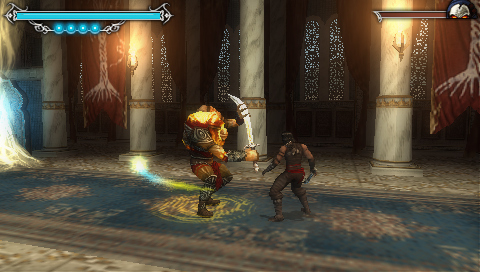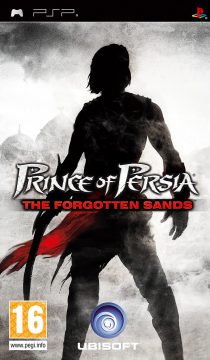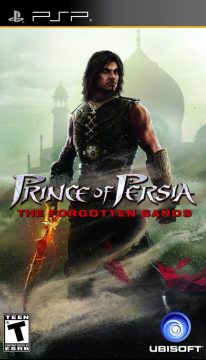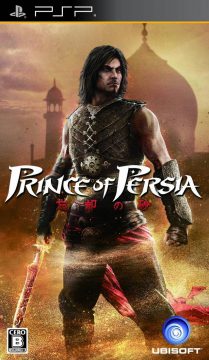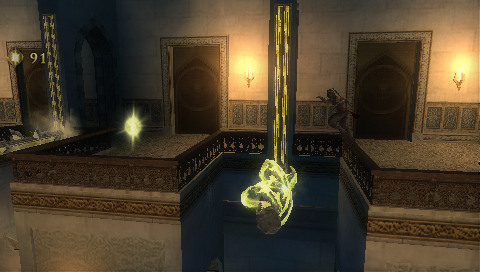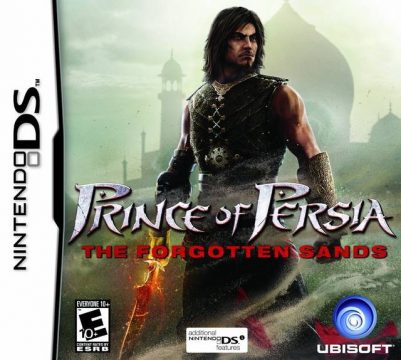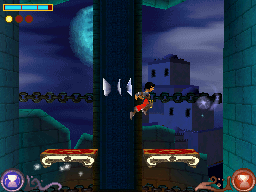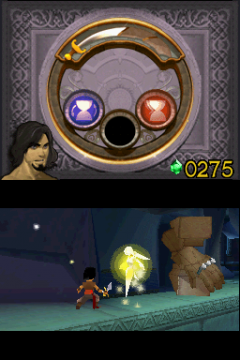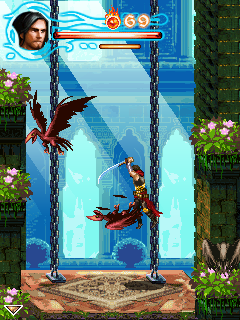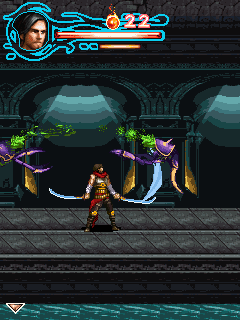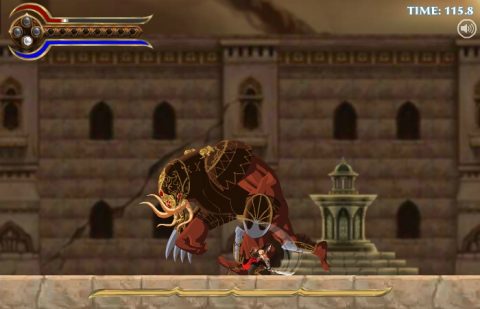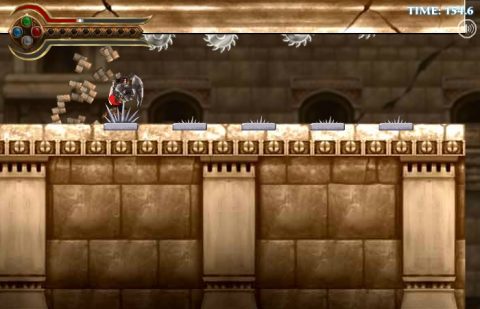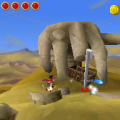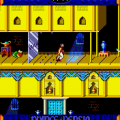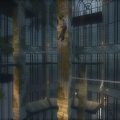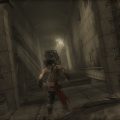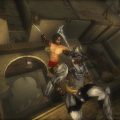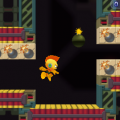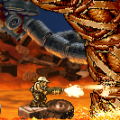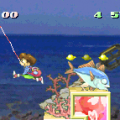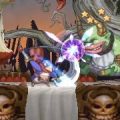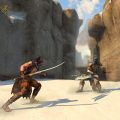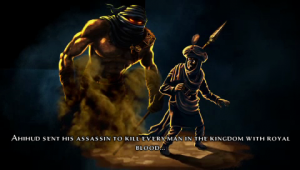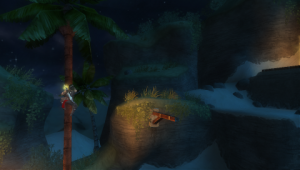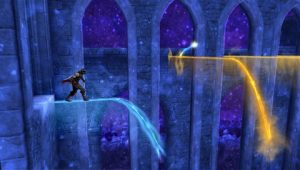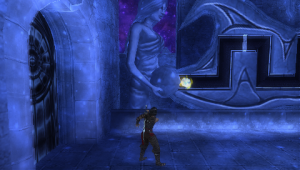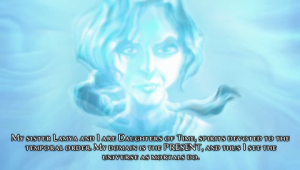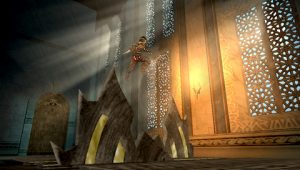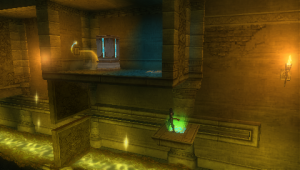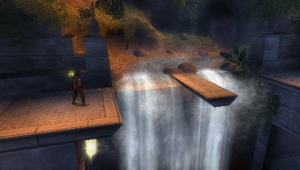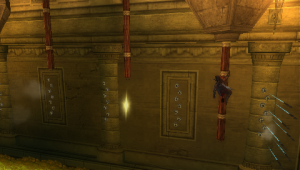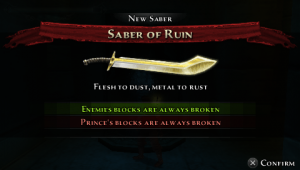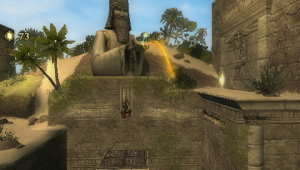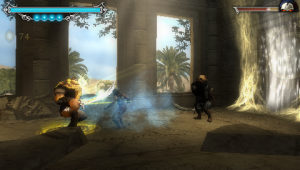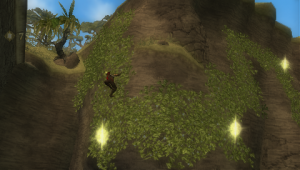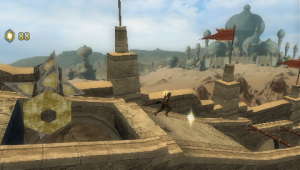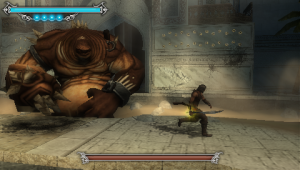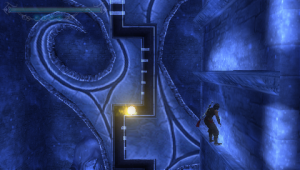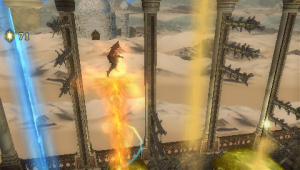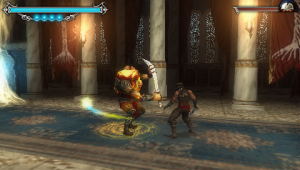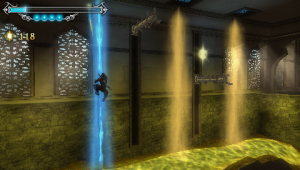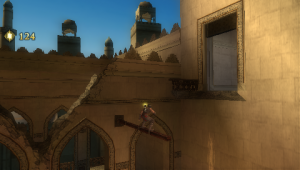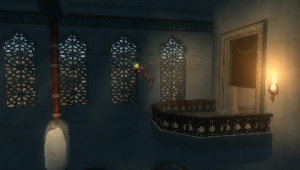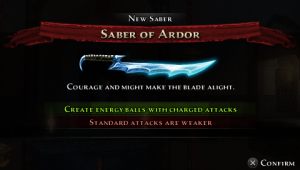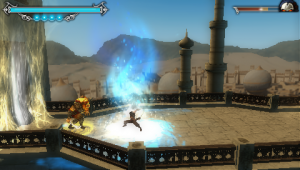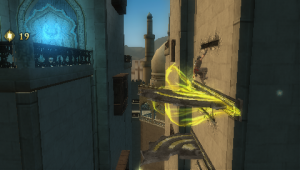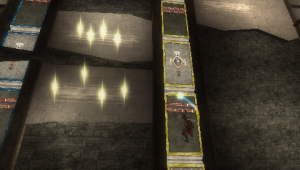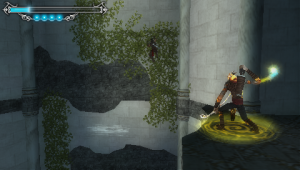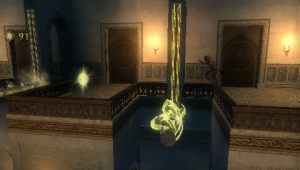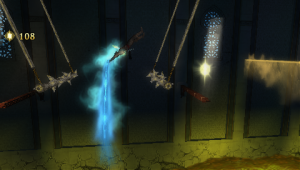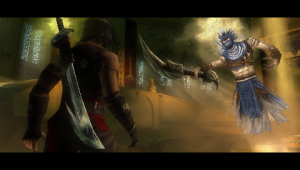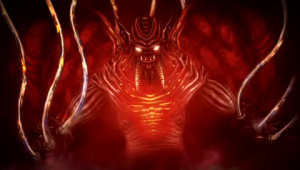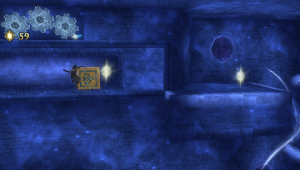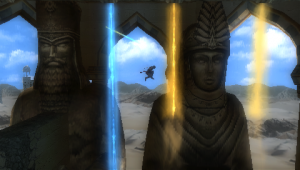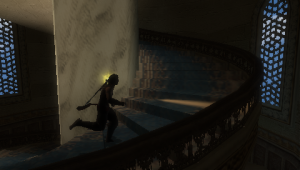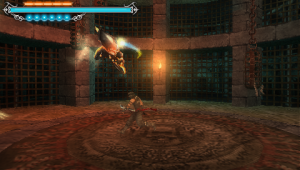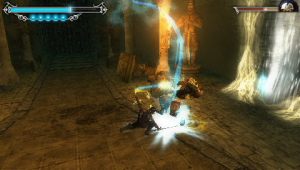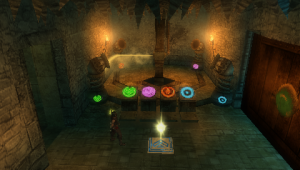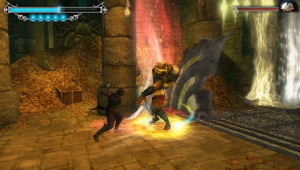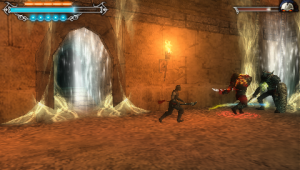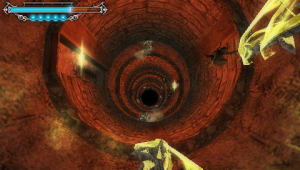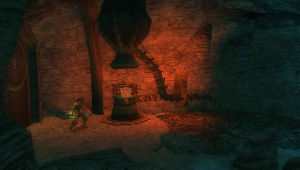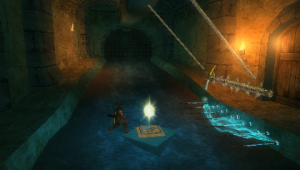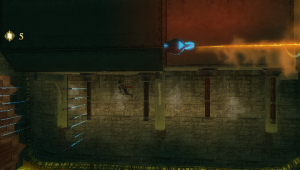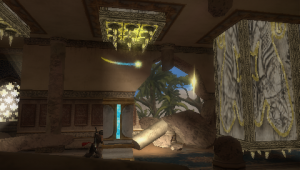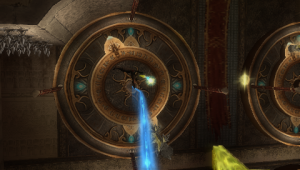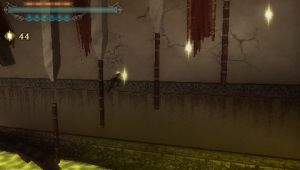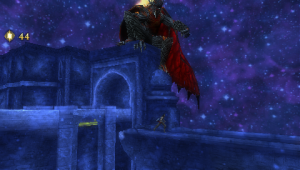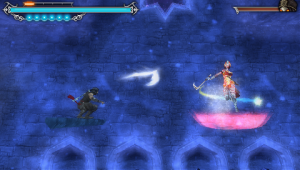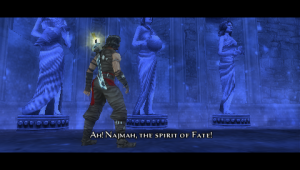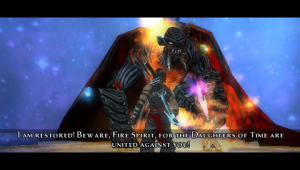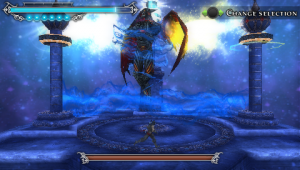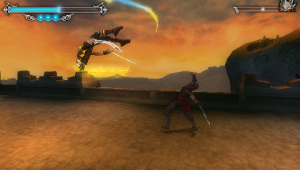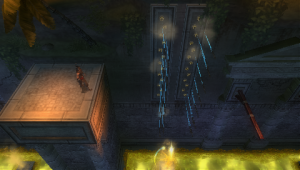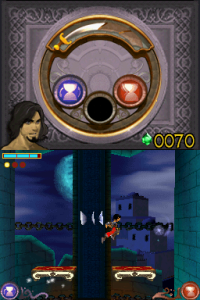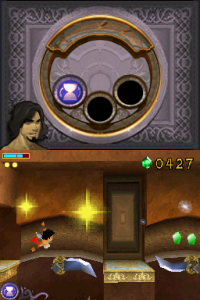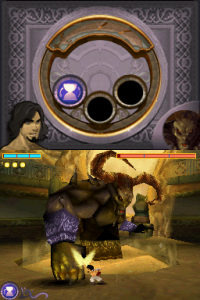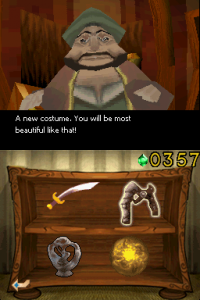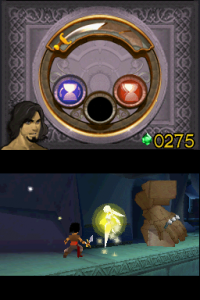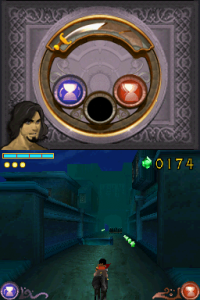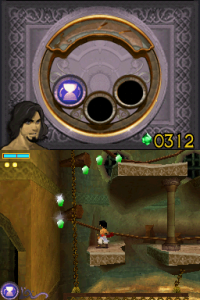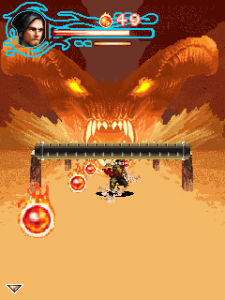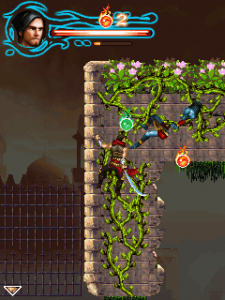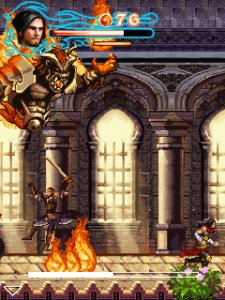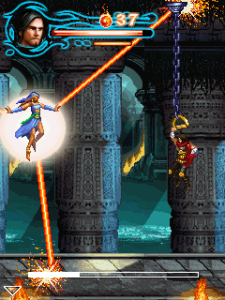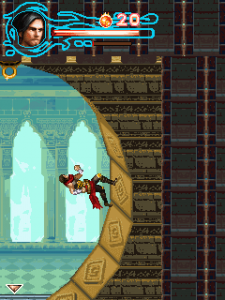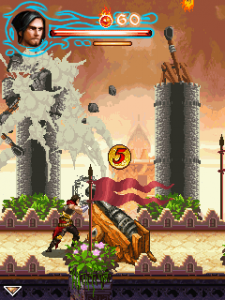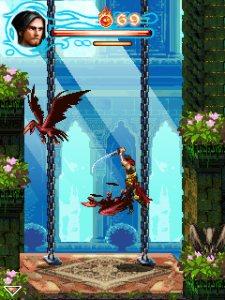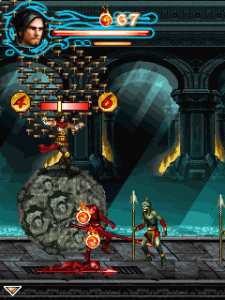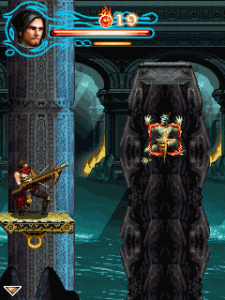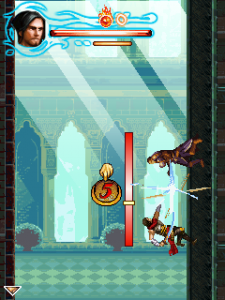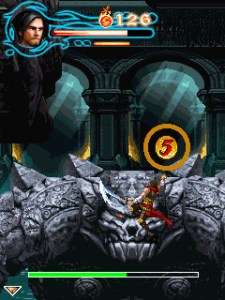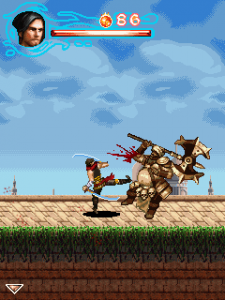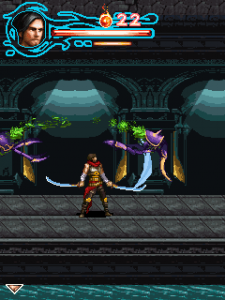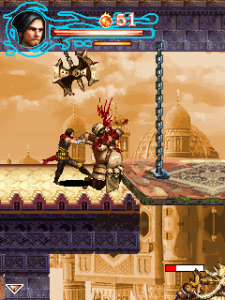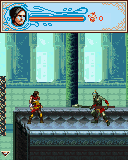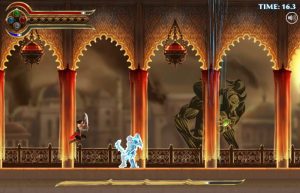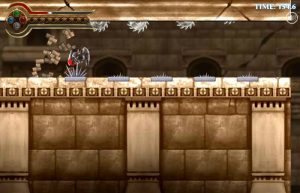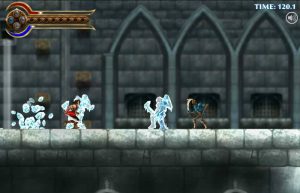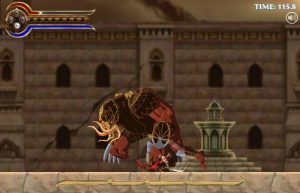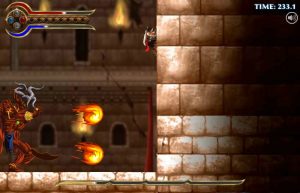- Prince of Persia
- Prince of Persia 2: The Shadow & The Flame
- Prince of Persia: Harem Adventures
- Prince of Persia 3D
- Prince of Persia: The Sands of Time
- Prince of Persia: Warrior Within
- Prince of Persia: The Two Thrones
- Battles of Prince of Persia
- Prince of Persia (2008)
- Prince of Persia: The Fallen King
- Prince of Persia: The Forgotten Sands (PS3/X360/WIN)
- Prince of Persia: The Forgotten Sands (Wii)
- Prince of Persia: The Forgotten Sands (Portable)
Like the Wii game, The Forgotten Sands on PSP tells an separate tale that is of no relation or consequence to anything that happens in the other installments. It was prophesized to the mighty fire spirit Ahihud that he would die through the hands of a member of the royal family of Persia, so he has them all killed, except for the Prince who is saved by yet another Genie called Helem.
On screenshots it might look just like its big brothers, but it is really a 2.5D platformer like the DS games, although the camera direction conveys a stronger illusion of three-dimensionality. But that also comes with a loss of visual clarity – it is not always entirely clear which objects belong to the background. There are also a few points were all of the Prince’s problems could be sidestepped easily if he wasn’t confined to one plane.
The Prince has all the agility from the more recent games. He can wall run both upwards and forward along certain background walls and holds on to ledges automatically. In a purely 2D environment, this almost makes things too easy, so in the early levels it feels almost like the game plays itself while you’re just holding right and occasionally pressing he jump button. The only major issue comes from pressing the button too often. The Prince lifts himself up automatically when pressing forward towards the ledge he his hanging onto, without there being an upwards input. So it feels naturally to press jump to get up. Due to a rather long control buffer, the game takes that input and interprets it into a jump after getting up, which usually results in the Prince leaping into the next instant death trap.
Similar to the Wii game, the Prince’s protecting spirit can prevent his demise a limited number of times per stage, which gets upgraded at certain spirit doors. After losing all the tries available, the hero still respawns at a safe spot usually not too far back, but the level rating (used to unlock bonus arts and other knick-knacks) suffers greatly from it.
Over the course of the game, the Prince gets to rescue Helem’s sisters from globes made out of glass, which grants the duo additional powers to bend the surroundings to their will. Helem keeps floating around the screen – looks like someone at Ubisoft Quebec was really fond of annoying little flying light bulbs – and latches on to whatever object the Prince comes close to. With the spirit of the future, she can then accelerate that object. Fountains of sand can be given enough force to push around heavy objects and even break certain walls, while whirlwinds take up the Prince higher up with some more rotations per minute.
The spirit of the past enables Helem to slow down objects to a freeze, which turns them into viable platforms. Once again all the challenge in the game stems from the necessity to combine these powers under time pressure. Turning a whirlwind into a solid block and pushing it with accelerated sand is just one of the simpler tasks, but eventually you’re going to have to freeze and accelerate objects in rapid succession – blow up whirlwinds, freeze streams of sand to climb up on them, slow down traps just to the right timing to squeeze through. Getting the timing down gets exceedingly difficult, especially in the few instances where the automatic targeting doesn’t work quite as it should. It’s possible to switch between targets by pressing left and right on the analog stick, but in the heat of action this is easier said than done, especially when the Prince also needs to be coordinated at the same time.
While most of the powers are just variations on things seen in other games, Helem’s magic can also influence enemies. Enemies can not only rendered immobile via time freezing, but speeding them up turns them into a heated frenzy where they simply mow down everything that comes in their way, including their own companions.
These powers come in incredibly helpful, as most enemies are formidable defenders and can take a while to beat the honest way. Eventually, though, the prince learns to jump up to the enemies and slash them from the air while their guard is down, or propel himself from a wall with incredible force. There’s also a powerful cyclone attack that takes up a while to charge, but obliterates everyone in front of him. There’s always the choice to invest points in health upgrades or special moves, but the latter make most fights so easy it makes Helem unnecessary most of the time.
Most combat takes place in boring flat arenas, but there are occasional opportunities to use time powers to smash enemies with surrounding traps. The concubines in the spirit world are particularly challenging. They fly high above and warp out of harm’s way immediately once the prince starts to climb up the beams that lead to them. So they have to be frozen in order to become reachable, but they break out of the spell after a short while. It’s also possible to put them in a frenzy so they cannot stop attacking, but that makes the ascend much more dangerous.
A bit disappointing is the asset recycling from the Wii version. The standard enemies underwent redesigns and have slightly different behavior to account for the omission of one dimension, but are still clearly the same basic monsters. It has the standard brutes (now lacking the vines that used to grow out of them on the Wii) with a regular and a stronger, armored version, the dangerous archers (which now sometimes appear in the foreground to shoot down the Prince while he is climbing), shield-bearing minotaurs and noticeably more evasive scarabs. The concubines are basically a mixture of the Temptress Assassin and Hamoa’s Priestess.
New, on the other hand, are the boss fights the Prince is challenged to every once in a while by particularly mighty foes. All of them are puzzle battles that become incredibly easy with the right approach. Most of all they require a lot of waiting, and neither reaches the complexity of the latter platforming segments. That includes the final confrontation against Ahihud, which is a major disappointment after the buildup where he flies in and destroys almost the whole palace piece by piece as the Prince tries to make his way to the top.
The PSP manifestation of The Forgotten Sands is neither the most innovative Prince of Persia nor the most substantial one. With 14 levels that can take anything between five and fifteen minutes to complete, plus three boss battles, it’s also a rather brisk experience. It is clear that this was made predominantly as a short distraction on the go. As such it is quite serviceable, although the mechanics can grow a bit tired towards the end, especially when the Prince needs to solve some laughable but overly long sand sprinkling puzzles without even any time pressure.
Prince of Persia: The Forgotten Sands – NDS (2010)
The Forgotten Sands on the Nintendo DS is kind of a sequel to the HD game, as the Prince is once again joined by Razia, but now she, too, has turned into a yellow Navi lookalike. Fortunately, however, she never flies around your head and only appears in cutscenes and as a portrait in the once again embarrassingly silly dialogue. The plot yet again is as non-committed as it gets: The Prince has been kidnapped to be abused for a Dark Ritual, during which he lost all his memories. Now he has to get them back and punish his kidnappers.
The Forgotten Sands runs on the same engine as The Fallen King, carrying along its inherent flaw of touchscreen controls that make the game ultimately boring. On a technical level, it works better thanks to more responsive controls, but that almost makes it worse. The platforming still is about as exciting as reordering files on your computer. Combat controls are slightly improved (read: made less aggravating) as now the Prince finally uses his normal attacks when the touchscreen is stroked. A stroke is a stroke is a stroke, though. There’s nothing of the depth and excitement you’d see in Ninja Gaiden: Dragon Sword, and enemies are little more than convenient health pack drops. Literally every enemy drops a healing potion unless the Prince is unscathed at the time of the kill.
The bosses are the worst yet. Fighting the first two (of four), you can literally just stand on a potion respawning spot and go do something else while they spawn their puny efforts to damage you in any significant way, come back just in time to dodge the attack that leaves them vulnerable, slash, repeat. The other two are only marginally more intelligent.
The level design isn’t quite as dull as in The Fallen King. Gone is the aggravating reliance on overly elaborate switch constructs, as are the stupid powerup doors. Instead, the diamonds that are dispersed throughout the levels are spent in a store that can be accessed from the world map at all times. Here the Prince gets to purchase additional health units, sand containers, (unneeded) sword upgrades and new outfits.
Even though Zal and his puzzle magic are gone, Razia bestows upon the prince a melange of known powers: Back are the Sands of Time with rewind and slow motion functions, and after each boss the Djinn learns to manipulate sands in new ways, which resemble some of the powers from The Fallen King and the PSP The Forgotten Sands. Their use is all too obvious, though, as usual. Every once in a while, a black horse appears out of nowhere for 3D riding sequences, which could be quite exciting, if they weren’t devoid of any challenging elements just like the rest of the game.
The Forgotten Sands on the DS is the superior game compared to Fallen King when examined under quantifying “good things / bad things” criteria, but in the end it’s just as boring and pointless. There’s no interesting story or worthwile effects (aside from the horse riding scenes), no particularly clever stage design to redeem the overly trivial core gameplay.
Prince of Persia: The Forgotten Sands – Mobile (2010)
The mobile phone version of The Forgotten Sands is the only port that retells the story of the major console game, although much abridged and modified. The game uses the same engine as Gameloft’s previous two Prince of Persia entries, but improves it with a lot of exciting new elements.
The Prince can now take over the weapons of certain enemies, so in some sections he gets to wield a giant axe or a crossbow, which are usually required to solve the next puzzle. At one point you even get access to a huge cannon to take out towers. The prince gets to interact with his brothe Malik every once in a while, at times you have to protect him from enemies while he’s turning a crank to ride an elevator or team up with him against bosses.
Razia is also on board, here she challenges the hero to a fight to test his worthiness. The forces she bestows upon him afterwards aren’t integrated quite as well, as they all use the same button and just act as fancy switch triggers, you never have to use them in mid-jump or in combination. The shooter levels have been replaced by an interesting “2nd person” 3D scene where the prince runs towards the screen to escape the big bad demon.
After the prude mobile Prince of Persia 2008, The Forgotten Sands is sexy again, although not in the usual way. Whenever he is hit by enemies or loses health in any other way, the Prince gradually loses shreds of his clothing, until he ends up completely shirtless.
There’s also a version for smartphones. It adds touchpad controls, which is precisely the way this game should not be played, and uses the graphics from the ordinary cellphone versions in scaled and filtered form. It looks pretty bad.
Prince of Persia: The Forgotten Sands – Flash (2010)
Finally, Ubisoft made The Forgotten Sands into a promotional flash game. It does use monsters and powers from the big console versions, but there’s no story to speak of.
Like the handheld versions, this is a 2D sidescroller, but here it the Prince constantly runs and jumps through the stage from left to right, only stopping when he hits a wall. From the beginning, he can use Sands of Time for rewinding, but in each further level he gains a new power. The dash makes longer jumps possible and also takes out enemies fast, Ice freezes enemies and waterfalls alike, securing the Prince’s path. Fire throws a projectile and protects from, well, fire. Then there’s the rock skin, which makes the Prince invulnerable for a time.
At the end of each stage awaits a boss. Here the Prince finally stops running and you can walk around freely, to fight, but most are only vulnerable to your latest special power. The final boss in the end constantly changes the color of his week spot, forcing you to cycle through the powers like crazy. You can submit your best time for each of the six levels to the leaderboards at Ubisoft.
